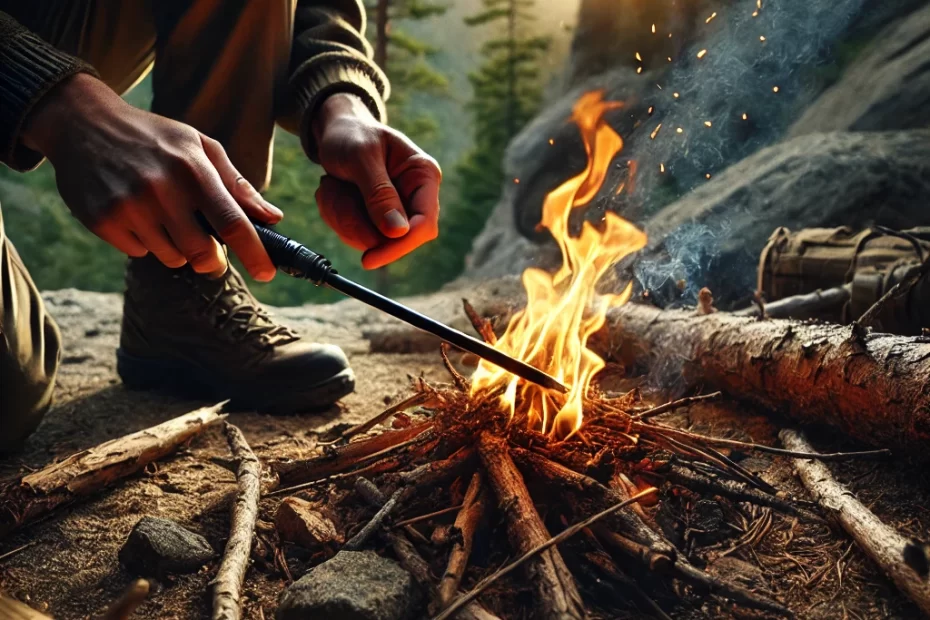Introduction:
Fire is one of the most critical survival elements. It provides warmth, light, protection, and the ability to cook food and purify water. Yet, many people struggle to start a fire when it matters most. This guide covers everything you need to know about fire-starting in survival situations, from real-life scenarios to expert techniques, mistakes to avoid, and advanced fire-starting hacks.
1. The Importance of Fire in Survival
Fire is essential for:
- Warmth: Prevents hypothermia in cold environments.
- Cooking: Makes food safer to eat and easier to digest.
- Water Purification: Boiling eliminates bacteria and parasites.
- Protection: Keeps wild animals at bay.
- Signaling for Rescue: Smoke and flames can attract attention from rescuers.
Real-Life Example: In 2013, a lost hiker in the Rockies survived for days by using a fire to keep warm and signal rescuers. Fire-making skills saved his life.
2. Essential Fire-Starting Tools
A prepared survivalist should always carry multiple fire-starting tools. Here are the best options:
Primary Fire Starters:
- Ferrocerium Rod: Produces sparks even in wet conditions.
- Waterproof Matches: A reliable backup.
- Lighter: A quick and easy option, but fuel can run out.
- Magnesium Block: Generates hot sparks to ignite tinder.
Natural Fire Starters:
- Fatwood: Resin-soaked wood that lights easily.
- Dried Grass and Leaves: Readily available in most environments.
- Cattail Fluff: Highly flammable, perfect for kindling.
3. Step-by-Step Guide to Building a Fire
- Find a Safe Location:
- Clear a 3-foot area of debris to prevent wildfires.
- Choose a site protected from wind and rain.
- Gather Your Materials:
- Tinder: Fine, dry materials like birch bark or shredded wood.
- Kindling: Small twigs and sticks (pencil-thick size).
- Fuel: Logs or larger branches to sustain the fire.
- Build the Fire Structure:
- Teepee Style: Best for quick ignition and strong flames.
- Log Cabin Style: Burns longer and steadier.
- Lean-To Style: Ideal for windy conditions.
- Ignite the Fire:
- Strike a ferro rod or use waterproof matches to ignite the tinder.
- Gently blow on the embers to spread the flames.
- Maintain the Fire:
- Add fuel gradually, starting with small sticks.
- Ensure continuous airflow to sustain combustion.
4. Common Fire-Starting Mistakes & How to Avoid Them
- Mistake #1: Using Wet Wood
- Solution: Look for dead, standing wood rather than wood on the ground.
- Mistake #2: Not Enough Tinder
- Solution: Always collect more tinder than you think you need.
- Mistake #3: Poor Fire Structure
- Solution: Build a proper teepee or log cabin structure for better airflow.
- Mistake #4: Rushing the Process
- Solution: Be patient; don’t smother the fire with too much wood too soon.
5. Pro Tips & Survival Hacks for Fire Starting
- Char Cloth: Pre-make char cloth by burning cotton fabric in a tin. It catches sparks instantly.
- Battery & Steel Wool Trick: Touch fine steel wool to a 9V battery for instant ignition.
- Lip Balm & Cotton Ball: Coat a cotton ball with lip balm or petroleum jelly for a long-burning fire starter.
- Duct Tape Fire Starter: A small strip of duct tape burns long enough to help light damp tinder.
6. Fire Safety & Extinguishing a Fire
Never leave a fire unattended. Before leaving:
- Drown it with water.
- Stir the ashes.
- Cover with dirt until completely cold.
Neglecting fire safety can lead to wildfires and severe consequences.
Final Thoughts
Fire is a survival essential, but it requires skill and preparation. By mastering these fire-starting techniques, you can ensure your survival in even the harshest conditions. What’s your go-to fire-starting method? Share your experiences in the comments!
